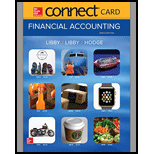
Concept explainers
Prepare the journal entries for each of the transactions.
Explanation of Solution
Sales are an activity of selling the merchandise inventory of a business.
Prepare the
| Date | Account titles and explanation | Debit ($) | Credit ($) |
| (a) | Cash | 235,000 | |
| Sales revenue | 235,000 | ||
| (To record the sale of merchandise for cash) | |||
| (b) | Accounts receivable | 11,500 | |
| Sales revenue | 11,500 | ||
| (To record the sale of merchandise on account) | |||
| (c) | Accounts receivable | 26,500 | |
| Sales revenue | 26,500 | ||
| (To record the sale of merchandise on account) | |||
| (d) | Sales returns and allowances | 500 | |
| Accounts receivable | 500 | ||
| (To record the sales return and allowance) | |||
| (e) | Accounts receivable | 24,000 | |
| Sales revenue | 24,000 | ||
| (To record the sale of merchandise on account) | |||
| (f) | Cash | 10,780 (2) | |
| Sales discounts | 220 (1) | ||
| Accounts receivable | 11,000 | ||
| (To record the collection of cash on account within the period) | |||
| (g) | Cash | 98,000 | |
| Sales discounts | 2,000 (4) | ||
| Accounts receivable | 100,000 (3) | ||
| (To record the collection of cash on account within the period) | |||
| (h) | Cash | 25,970 (6) | |
| Sales discounts | 530 (5) | ||
| Accounts receivable | 26,500 | ||
| (To record the collection of cash on account within the period) | |||
| (i) | Accounts receivable | 19,000 | |
| Sales revenue | 19,000 | ||
| (To record the sale of merchandise on account) | |||
| (j) | Sales returns and allowances | 3,500 (7) | |
| Cash | 3,430 (9) | ||
| Sales discounts | 70 (8) | ||
| (To record the sales returns and allowances) | |||
| (k) | Cash | 6,000 | |
| Accounts receivable | 6,000 | ||
| (To record the collection of cash on account after the period) | |||
| (l) | Allowance for doubtful account | 3,000 | |
| Account receivable | 3,000 | ||
| (To record the write-off of uncollectible account receivable ) | |||
| (m) | 1,155 (10) | ||
| Allowance for doubtful accounts | 1,155 | ||
| (To record the bad debt expense) | |||
Table (1)
Working Notes:
Calculate sales discount of 2% for the amount of $11,000 collected from R.
Determine cash collected from R.
Calculate the total accounts receivable amount.
Determine sales discount given to customer.
Calculate sales discount of 2% for the amount of $26,500 collected from M.
Determine cash collected from M.
Calculate the amount of sales returns made from M.
Calculate sales discount of 2% for the amount of $3,500.
Determine cash returned to M.
Calculate the bad debt expense.
Calculate the net sales.
2.
Show how the accounts related to the preceding sale and collection activity should be shown on the income statement.
2.
Explanation of Solution
Income statement: This is a financial statement that shows the net income earned or net loss suffered by a Company through reporting all the revenues earned and expenses incurred by the company over a specific period of time. An income statement is also known as an operations statement, an earnings statement, a revenue statement, or a
Show the accounts related to the preceding sale and collection activity should be shown on the income statement.
| Company S | |
| Income Statement | |
| As of December 31 | |
| Particulars | Amount ($) |
|
Sales Revenue | 316,000 |
| Less: Sales Returns and Allowances | 4,000 |
| Less: Sales Discount | 2,680 |
| Net Sales Revenue | 309,320 |
| Operating Expenses: | |
| Bad Debt Expense | 1,155 |
Table (2)
Want to see more full solutions like this?
Chapter 6 Solutions
Connect Access Card for Financial Accounting
- Sunset Manufacturing Company applies manufacturing overhead based on labor-hours. At the beginning of the year, the company based its predetermined overhead rate on total estimated overhead of $75,000. Actual manufacturing overhead for the year was $72,000, and actual labor-hours were 6,000. The company's predetermined overhead rate for the year was $12.50 per labor-hour. What is the applied manufacturing overhead for the year?arrow_forwardCan you solve this financial accounting question with accurate accounting calculations?arrow_forwardCan you demonstrate the proper approach for solving this financial accounting question with valid techniques?arrow_forward
 College Accounting (Book Only): A Career ApproachAccountingISBN:9781337280570Author:Scott, Cathy J.Publisher:South-Western College Pub
College Accounting (Book Only): A Career ApproachAccountingISBN:9781337280570Author:Scott, Cathy J.Publisher:South-Western College Pub Intermediate Accounting: Reporting And AnalysisAccountingISBN:9781337788281Author:James M. Wahlen, Jefferson P. Jones, Donald PagachPublisher:Cengage Learning
Intermediate Accounting: Reporting And AnalysisAccountingISBN:9781337788281Author:James M. Wahlen, Jefferson P. Jones, Donald PagachPublisher:Cengage Learning College Accounting (Book Only): A Career ApproachAccountingISBN:9781305084087Author:Cathy J. ScottPublisher:Cengage Learning
College Accounting (Book Only): A Career ApproachAccountingISBN:9781305084087Author:Cathy J. ScottPublisher:Cengage Learning Cornerstones of Financial AccountingAccountingISBN:9781337690881Author:Jay Rich, Jeff JonesPublisher:Cengage Learning
Cornerstones of Financial AccountingAccountingISBN:9781337690881Author:Jay Rich, Jeff JonesPublisher:Cengage Learning Financial AccountingAccountingISBN:9781337272124Author:Carl Warren, James M. Reeve, Jonathan DuchacPublisher:Cengage Learning
Financial AccountingAccountingISBN:9781337272124Author:Carl Warren, James M. Reeve, Jonathan DuchacPublisher:Cengage Learning College Accounting, Chapters 1-27AccountingISBN:9781337794756Author:HEINTZ, James A.Publisher:Cengage Learning,
College Accounting, Chapters 1-27AccountingISBN:9781337794756Author:HEINTZ, James A.Publisher:Cengage Learning,





